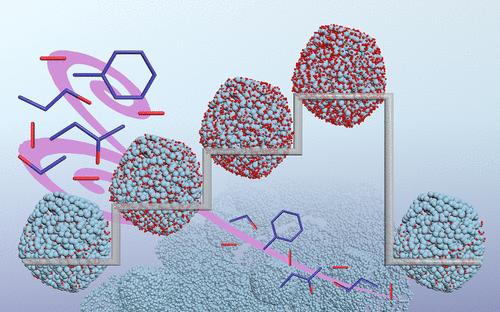Our official English website, www.x-mol.net, welcomes your
feedback! (Note: you will need to create a separate account there.)
Kinetic Modeling in Temperature-Modulated Semiconductor Gas Sensor Utilizing Eley–Rideal Mechanism and Its Application in Discriminative Detection of VOCs
ACS Sensors ( IF 8.2 ) Pub Date : 2024-11-14 , DOI: 10.1021/acssensors.4c01835 Wei Zhang, Zhenyu Yuan, Hongmin Zhu, Shouwen Zhang, Fanli Meng
ACS Sensors ( IF 8.2 ) Pub Date : 2024-11-14 , DOI: 10.1021/acssensors.4c01835 Wei Zhang, Zhenyu Yuan, Hongmin Zhu, Shouwen Zhang, Fanli Meng

|
This study presents a comprehensive kinetic investigation for describing the dynamic sensing process of semiconductor metal oxide (SMO)-based gas sensors, with a focus on the Eley–Rideal mechanism as a valid pathway. The modeling elucidates the direct interactions between volatile organic compounds (VOCs) and adsorbed oxygen on the material surface, providing insights into the temperature-dependent response characteristics of the sensor and addressing selectivity toward different VOCs fundamentally. By incorporating the effects of thermal modulation, the kinetic model was validated through theoretical fitting of experimental data obtained from a fabricated SnO2 nanoparticle gas sensor exposed to ethanol, n-propanol, toluene, and butanone at systematically varying operating temperatures. The results demonstrated that the model accurately captures response transient values, enabling a general framework for qualitatively discriminating specific gases based on their unique reaction kinetics. Furthermore, a machine learning procedure containing the above model and power laws of quantitative concentrations after identifying compounds was developed for the prediction of target VOCs. The qualitative accuracy was determined to be 99.4%, while quantifying with the mean absolute errors of 5.0, 7.5, 4.0, and 8.9 within the range of 25–200 ppm, respectively. The precise and straightforward strategy facilitates the response modeling of SMO-based gas sensors, offering a valuable platform for the designing model-driven algorithms applicable in gas analysis and monitoring.
中文翻译:

利用 Eley-Rideal 机制的调温半导体气体传感器动力学建模及其在 VOCs 判别检测中的应用
本研究为描述基于半导体金属氧化物 (SMO) 的气体传感器的动态传感过程进行了全面的动力学研究,重点是 Eley-Rideal 机制作为有效途径。该建模阐明了挥发性有机化合物 (VOC) 与材料表面吸附氧之间的直接相互作用,从而深入了解传感器随温度变化的响应特性,并从根本上解决对不同 VOC 的选择性问题。通过结合热调制的影响,动力学模型通过对在系统变化的工作温度下暴露于乙醇、正丙醇、甲苯和丁酮的制造的 SnO2 纳米粒子气体传感器获得的实验数据进行理论拟合来验证。结果表明,该模型准确地捕获了响应瞬态值,从而为根据特定气体的独特反应动力学定性区分特定气体提供了一个通用框架。此外,开发了一种包含上述模型和鉴定化合物后定量浓度幂律的机器学习程序,用于预测目标 VOCs。定性准确度确定为 99.4%,同时在 25-200 ppm 范围内分别使用 5.0、7.5、4.0 和 8.9 的平均绝对误差进行量化。精确而直接的策略有助于对基于 SMO 的气体传感器进行响应建模,为设计适用于气体分析和监测的模型驱动算法提供了一个有价值的平台。
更新日期:2024-11-14
中文翻译:

利用 Eley-Rideal 机制的调温半导体气体传感器动力学建模及其在 VOCs 判别检测中的应用
本研究为描述基于半导体金属氧化物 (SMO) 的气体传感器的动态传感过程进行了全面的动力学研究,重点是 Eley-Rideal 机制作为有效途径。该建模阐明了挥发性有机化合物 (VOC) 与材料表面吸附氧之间的直接相互作用,从而深入了解传感器随温度变化的响应特性,并从根本上解决对不同 VOC 的选择性问题。通过结合热调制的影响,动力学模型通过对在系统变化的工作温度下暴露于乙醇、正丙醇、甲苯和丁酮的制造的 SnO2 纳米粒子气体传感器获得的实验数据进行理论拟合来验证。结果表明,该模型准确地捕获了响应瞬态值,从而为根据特定气体的独特反应动力学定性区分特定气体提供了一个通用框架。此外,开发了一种包含上述模型和鉴定化合物后定量浓度幂律的机器学习程序,用于预测目标 VOCs。定性准确度确定为 99.4%,同时在 25-200 ppm 范围内分别使用 5.0、7.5、4.0 和 8.9 的平均绝对误差进行量化。精确而直接的策略有助于对基于 SMO 的气体传感器进行响应建模,为设计适用于气体分析和监测的模型驱动算法提供了一个有价值的平台。






























 京公网安备 11010802027423号
京公网安备 11010802027423号